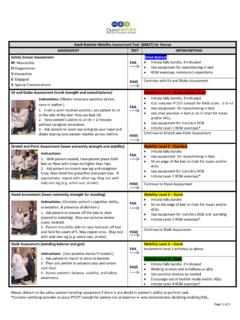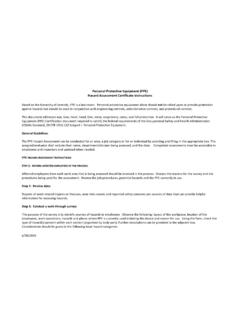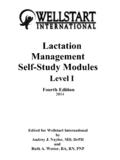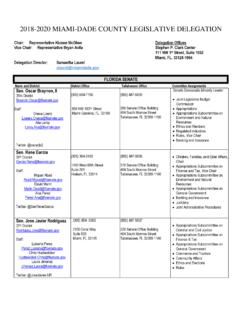Transcription of Duke University Hospital Duke University Police Department ...
1 Duke University Hospital Duke University Police Department Security Management Plan Effective Date: 03/2021 1 of 12 I. Table of Contents: I Table of Contents II Authority III Purpose & Scope IV Policy Statement V The Joint Commission Standards VI Performance Standards VII DUPD Services VIII Evaluation of Plan IX Performance Improvement Project(s) X Applicable Reference Documents XI Approval II. Authority 2015 The Joint Commission Environment of Care Standard requires this plan III. Purpose and Scope The Duke University Police Department (DUPD) exists to support and facilitate Duke University Hospital s missions of education, research and patient care. The policies herein apply to all Duke University Hospital and Clinic employees working within DUPD jurisdiction. Clinics or facilities outside of the DUPD jurisdiction will develop site-specific security plans that coordinate with this plan. The Duke University Hospital campus includes Duke University Hospital , Children health Center, Clinics Building, Cancer Center, Eye Center, North Pavilion and The Duke Medical Pavilion Employees working outside DUPD jurisdiction will receive emergency Police response from the law enforcement agency within their jurisdiction.
2 However, DUPD upon request may provide in-services and security consulting to all entities of the health System including those that are outside of their direct jurisdiction. This document outlines how Duke University Hospital & Clinics address security issues concerning patients, visitors, personnel and property IV. Policy Statement It is the policy of Duke Hospital and Clinics to provide a safe environment to all persons interacting within the Hospital and /or clinics. The plan is a core element of the Environment of Care program that supports the Duke University Hospital mission of Duke University Hospital Duke University Police Department Security Management Plan Effective Date: 03/2021 2 of 12 providing exceptional quality in patient care within a teaching and research healthcare organization. Duke University Hospital Duke University Police Department Security Management Plan Effective Date: 03/2021 3 of 12 V. The Joint Commission Standards Standard , EP 1: The organization identifies and manages its security risks associated with the environment of care.
3 Risks are identified from internal sources such as ongoing monitoring of the environment, results of root cause analyses, results of annual proactive assessments of high-risk processes, and from credible external sources. Rationale: It is essential that an organization manage the physical and personal security of patients, staff (including addressing the risks of violence in the workplace) and individuals coming to the organization s facilities. In addition, security of the established environment, equipment, supplies, and information is also important. To achieve this, the organization must: A. Develop and maintain a Security Management Plan describing the processes it implements to effectively manage the security of patients, staff, and other people coming to the organization s facilities. B. Identify a person(s), as designated by leadership, to coordinate the development, implementation, and monitoring of the security management activities.
4 The person(s) designated are: 1. Chief of Duke University Police Department : Duke University Hospital Administration has delegated responsibility for the institutional program to the Chief who is assisted by managers, supervisors, and administrative support staff. The Chief is responsible to the Vice President of Duke University human Resources. Chief has delegated responsibility for the security management plan to the Medical Center Security Manager and delegated operational responsibility to the Operations Commander. 2. Medical Center Security Manager: A member of the Department who is the Chief s representative and liaison to administration of Duke University Hospital , Duke Clinics, Ambulatory Services and the School of Medicine. This member ensures that DUPD policies and practices comply with The Joint Commission established standards as well as Hospital and Clinic missions. 3. Operations Commander: A member of the Department who oversees all operational issues.
5 C. Conduct proactive risk assessments that evaluate the potential adverse impact of the external environment and the services provided on the security of patients, staff, and other people coming to the organization s facilities. The potential for workplace violence is considered during the risk assessment process. They are conducted by the following: Duke University Hospital Duke University Police Department Security Management Plan Effective Date: 03/2021 4 of 12 1. Facilities Services Work G roup: A subcommittee of the Safety Committee, this group is charged with reviewing all requests relating to security technologies. Recommendations and implementation of security upgrades throughout the Hospital and clinics are processed through this subcommittee . Departments may request a risk/needs assessment for their area or Duke University Hospital Administration and Duke University Police Department may deem a risk/needs assessment is necessary for the protection and safety of patients, visitors, staff and property.
6 This group meets routinely, compiles minutes of each meeting and reports significant findings to the Duke University Safety Committee (DUSC). Departments represented are: Engineering and Operations, Fire Safety, Hospital Administration, Facility Planning and Design Office, Infection Control, and Police /Security. 2. Duke Police Crime Prevention: This division is responsible for all security assessments concerning facilities. Working in collaboration with the Facilities Work Group and the Office of Information Technology, they may make recommendations for security technology upgrades to ensure consistency. This division also conducts training for health System staff reference secure and safe work place programs 3. Emergency Preparedness Committee: A subcommittee of the Safety Committee is charged with providing a Hazard Vulnerability Assessment on an annual basis. The results of the assessment are reported to the Safety Committee and include security issues.
7 4. Workplace Violence: Protecting patients, visitors and staff is our highest priority. We work with Risk Management and other departments to reduce the risk of violence. The University has several (BAT) Behavior Assessment Teams to look at concerning behavior and recommends strategies to prevent violence. The crime prevention section developed and delivers education focused on violence in the healthcare setting. Response to threats or violence may include numerous remedies, depending on the situation. Groups above utilize one or more of the following processes in determining the needs of the facility. External Safety and Security tours, Lighting and Grounds tours EOC walkthrough surveys Security Officer day & night checks Duke Police Emergency phone checks Duke University Hospital Duke University Police Department Security Management Plan Effective Date: 03/2021 5 of 12 D. Implement procedures and controls (takes action) to minimize or eliminate identified security risks identified through the risk assessment process ( , EP 3).
8 The Workplace Security Group is a branch of the DUSC that makes recommendations to mitigate security risks. These recommendations are presented to administration and sometimes initiate changes to policy, procedures, and/or training. E. Identify, as appropriate, patients, staff, and other people entering the organizations facilities ( , EP 7). Credentialing standards have been established for the following groups: 1. Contractors: The Project Manager must coordinate with the Facilities Planning, Design and Construction Office to ascertain credentials for long-term contractors. Short-term contractors will wear their company identification badge and/or logo apparel. Contractors doing work in off-site Clinics/facilities will communicate with the Building Manager and Clinic Manager as to how their employees will be identified. 2. Employees: The procedure for identifying Duke University Hospital and Clinics Staff is outlined in the Duke University Hospital Policy Employee Identification Badge.
9 All employees must wear their ID badge per Hospital Policy while on duty. Duke Police Officers and Security Officers in uniform will have their Identification badge with them while on duty. Officers out of uniform must wear their ID badge on the outer clothing between shoulder and above the waist with the photo side facing out when they are in an official capacity. 3. Patients: All patients are provided with identification bands worn conspicuously on their wrist. 4. Visitors: DUPD helps ensure compliance to Duke Hospital visitation policy. Note: Hospital Administration has given the responsibility for employee and contractor identification cards to the Duke Card Office. F. Control access to and egress from security sensitive areas, as determined by the organization. The following areas have been determined to be security sensitive ( , EP 8). The specific access and egress practices are listed for each. 1. Emergency Department : The public, main entrance to the Emergency Department is staffed by DUPD 24/7.
10 DUPD follows their General Orders for screening individuals entering through this entrance. Their personal items are Duke University Hospital Duke University Police Department Security Management Plan Effective Date: 03/2021 6 of 12 also screened with an x-ray unit. All other interior and exterior doors leading to the patient care areas are equipped with electronic access control and activated 24-7. Additionally, the locked psychiatric unit within the Emergency Department is controlled by electronic access control. 2. In-Patient Psychiatric Unit: All entrances are equipped with a traditional key or electronic locking mechanism and secured 24/7. 3. Mother Baby Unit: All entrances are equipped with a traditional key or electronic locking mechanism. A digital surveillance system records activity 24/7 and stores data on a NVR Computer Server for 30 days. All ingress/egress doors are equipped with the HUGS Infant Protection System. 4. Pediatric In-Patient Units: All entrances are equipped with a traditional key or electronic locking mechanism, with the exception of 5100, 5200 and 5300 units.















